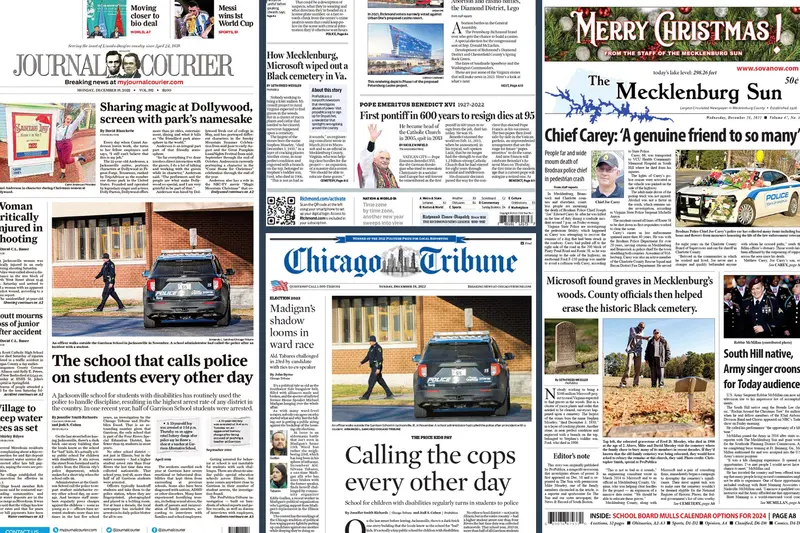The Single Strategy To Use For News Articles
The Single Strategy To Use For News Articles
Blog Article
Excitement About News Articles
Table of ContentsThe Best Guide To News ArticlesSome Known Factual Statements About News Articles News Articles Fundamentals ExplainedThings about News ArticlesNot known Details About News Articles
Excellent knowledge of various subjects provides students a competitive side over their peers. Even though digital and social networks are easily accessible, we should not neglect exactly how essential it is to read the papers. Moms and dads need to try and instill the practice of reviewing a paper as a day-to-day routine to proceed the legacy of the adored print tool.News stories additionally have at least one of the adhering to important qualities family member to the desired target market: proximity, importance, timeliness, human rate of interest, anomaly, or effect.
Within these restrictions, information tales also intend to be extensive. Nonetheless, various other variables are entailed, some stylistic and some acquired from the media form. Among the larger and much more revered papers, justness and equilibrium is a significant variable in offering details. Discourse is generally constrained to a different section, though each paper might have a different overall slant.
Papers with an international target market, for instance, often tend to utilize a more official design of creating. News Articles.; usual design guides consist of the and the US Information Style Book.
How News Articles can Save You Time, Stress, and Money.
As a regulation, journalists will not make use of a lengthy word when a short one will do. They use subject-verb-object building and construction and vibrant, energetic prose (see Grammar). They use stories, instances and metaphors, and they seldom depend upon generalizations or abstract concepts. News authors attempt to avoid utilizing the exact same word extra than when in a paragraph (in some cases called an "echo" or "word mirror").
Headlines often leave out the subject (e.g., "Jumps From Watercraft, Catches in Wheel") or verb (e.g., "Feline lady lucky"). A subhead (also subhed, sub-headline, subheading, subtitle, deck or dek) can be either a subordinate title under the main headline, or the heading of a subsection of the article. It is a heading that comes before the primary text, or a group of paragraphs of the major message.

Additional signboards of any of these types might appear later in the short article (particularly on subsequent web pages) to lure further reading. Such signboards are also made use of as guidelines to the write-up in other areas of the magazine or website, or as ads for the piece in other publication or websites. Common structure with title, lead paragraph (recap in strong), various other paragraphs (details) and contact find here information.
Example of a hard-lead paragraph NASA is proposing another area job. The company's budget plan request, announced today, included a plan to send one more objective to the Moon. This time the agency intends to develop a lasting center as a jumping-off place for various other area experiences. The budget plan requests approximately $10 billion for the project.
The NASA news came as the firm requested $10 billion of appropriations for the task. An "off-lead" is the 2nd crucial front web page news of the day. The off-lead appears visit either in the top left corner, or straight listed below the lead on the right. To "bury the lead" is to start the post with history information or details of secondary value to the viewers, compeling them to learn more deeply right into a post than they must need to in order to discover the important factors.
The Ultimate Guide To News Articles
Typical use is that one or two sentences each develop their very own paragraph. Journalists generally describe the organization or structure of a newspaper article as an upside down pyramid. The essential and most interesting aspects of a tale are placed at the start, with sustaining information complying with in order of reducing significance.
It permits individuals to discover a subject to just the deepness that their inquisitiveness takes them, and without the charge of information or subtleties that they can think about unnecessary, yet still making that details readily available to more interested visitors. The upside down pyramid framework additionally makes it possible for write-ups to be trimmed to any type of arbitrary length during layout, to suit the room readily available.
Some authors begin their stories with the "1-2-3 lead", yet there are lots of kinds of lead available. This format usually begins with a "5 Ws" opening up paragraph (as defined above), complied with by an indirect quote that serves to sustain a significant aspect of the very first paragraph, and after that a direct quote to support the indirect quote. [] A twist can refer to numerous points: The last tale in the information broadcast; a "satisfied" story to end the show.
Longer write-ups, such as magazine cover write-ups and the pieces that lead the within sections of a i loved this paper, are understood as. Attribute stories differ from straight information in a number of means.
The Main Principles Of News Articles
The journalist commonly information interactions with interview subjects, making the item extra individual. A feature's initial paragraphs usually relate an intriguing moment or event, as in an "anecdotal lead". From the particulars of an individual or episode, its view swiftly broadens to generalizations concerning the story's subject. The area that signals what a function has to do with is called the or billboard.

The Editor's Toolbox: A Reference Overview for Beginners and Professionals (2001) Allan M. Siegal and William G. Connolly. The New York Times Guidebook of Style and Usage: The Authorities Style Overview Used by the Writers and Editors of the Globe's Many Authoritative Paper (2002) M. L. Stein, Susan Paterno, and R.
Report this page